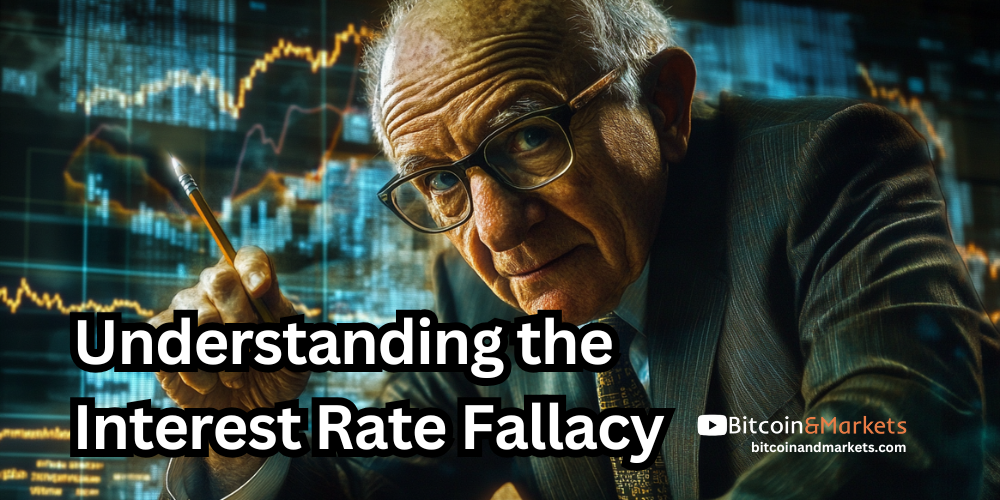Understanding The Interest Rate Fallacy
The belief that low rates lead people to borrow more and expand credit is wrong.

Originally published on Bitcoin Magazine, then on BTCM.co
“After the U.S. experience during the Great Depression, and after inflation and rising interest rates in the 1970s and disinflation and falling interest rates in the 1980s, I thought the fallacy of identifying tight money with high interest rates and easy money with low interest rates was dead. Apparently, old fallacies never die.”
-Milton Friedman, “ Reviving Japan,” 1998

I cannot provide this important Bitcoin and Macro analysis without you.
Bitcoin & Markets is enabled by readers like you!
In this article, I want to take a deeper look at a very common misconception about interest rates—namely, that low rates are a sign of easy money and stimulus. This misguided belief can lead people to make incorrect assessments about inflation and, by extension, their investment thesis. Today, we cover the “interest rate fallacy.”
A large part of the conventional inflation story, drilled into us by the negligent economists in academia and at the Federal Reserve, is the belief that low rates lead people to borrow more and expand credit, essentially 'print money.' They want us to believe the Fed sets rates low as an easy money policy to cause growth and inflation. On top of this, they promote the idea that low rates plus quantitative easing (QE) is extra inflationary, as if they are unleashing a biblical flood of liquidity and money printing. In other words, they are God in their story.
All schools of thought that I’m familiar with agree that low rates are stimulatory: Classical, Keynesian, Monetarist and even my beloved Austrian School. It’s a nearly-universally held dogma that is objectively wrong.
Milton Friedman And The Interest Rate Fallacy
The interest rate fallacy was outlined by Milton Friedman all the way back in 1968, in “The Role Of Monetary Policy,” published by The American Economic Review. He wrote this prior to the Nixon Shock, when the U.S. was still on a gold standard, but the monetary system was already working as if it were fully credit-based system. Here is the essential bit:
“As an empirical matter, low interest rates are a sign that monetary policy has been tight — in the sense that the quantity of money has grown slowly; high interest rates are a sign that monetary policy has been easy — in the sense that the quantity of money has grown rapidly. The broadest facts of experience run in precisely the opposite direction from that which the financial community and academic economists have all generally taken for granted.
“Paradoxically, the monetary authority could assure low nominal rates of interest — but to do so it would have to start out in what seems like the opposite direction, by engaging in a deflationary monetary policy.”
-Milton Friedman, “ The Role Of Monetary Policy,” 1968
Friedman clearly argued that interest rates follow from monetary conditions —whether they “have been tight” or “have been easy.” Interest rate moves do not lead to the monetary conditions. Low interest rates do not cause monetary expansion, it is a deflationary environment that causes low rates.
How do you get monetary expansion? One might say, “lower rates,” but historical observations suggest otherwise. If we are stuck in an ultra-low interest rate environment, either the monetary conditions are naturally tight, or the Fed has made those conditions artificially tight somehow. Low rates do NOT mean 'easy' monetary policy.
There are essentially two possible monetary conditions: expanding or contracting. This means any period of contraction with low interest rates will naturally be followed by an expansion and, consequently, rising interest rates. This creates a pattern for our primate brains: “Low rates are followed by expansion.”
While technically true, it is not a causative relationship. Low rates could be followed by continued tight monetary conditions and even lower rates, but we wouldn’t see this as a new instance of low rates. Eventually, expansion will return, and rates will begin to rise. Thus, you have low rates appearing to lead to expansion.
Although Friedman said that “monetary policy has been tight,” he did not mean “interest rate policy.” I interpret this term as indicating monetary conditions, because he did not see interest rates as the all-consuming policy choice, or even a viable one.
“These considerations not only explain why monetary policy cannot peg interest rates; they also explain why interest rates are such a misleading indicator of whether monetary policy is “tight” or “easy” [because of the interest rate fallacy]. For that, it is far better to look at the rate of change of the quantity of money.”
-Milton Friedman, “ The Role Of Monetary Policy,” 1968
Friedman tied low rates to prevailing monetary conditions but stopped short of linking low rates directly to the level of economic growth. He stated that steady monetary growth can only provide a “favorable climate” for economic growth.
“But steady monetary growth would provide a monetary climate favorable to the effective operation of those basic forces of enterprise, ingenuity, invention, hard work, and thrift that are the true springs of economic growth.”
-Milton Friedman, “ The Role Of Monetary Policy,” 1968
Richard Werner On Growth And Interest Rates
Five decades after Friedman, Richard Werner would find the empirical link between monetary conditions and economic growth through the lens of the interest rate fallacy.
Werner, the German economist who coined the term “quantitative easing,” published a study in 2018 examining 50 years of data from the four major central banks (in Germany, Japan, the U.K., and the U.S.), comparing economic growth and interest rates from 1957 to 2008.
What Werner found was that interest rates actually followed the direction of economic growth. Instead of acting as a causal factor for economic expansion, interest rates are the dependent variable that mirrors levels of growth in the economy. This discovery directly contradicts the conventional view that interest rates drive economic expansion. In short, after collecting and analyzing 50 years of post-World War II data, Werner found that lower interest rates do not stimulate the economy—rather, low interest rates indicate low growth.
Now, we have two key insights from Werner’s findings that align closely with Friedman’s interest rate fallacy: for Friedman, tight monetary conditions led to low interest rates; for Werner, low growth led to low interest rates. Together, they show that low interest rates signify tight money and low growth in a credit-based system. Conversely, if there is easy money—i.e., accelerating money printing—rates will not be low.
Today, persistently low and negative rates worldwide cannot signify high levels of money printing. Instead, they indicate that money printing has been muted or declining.
Credit-Based Systems
This makes sense when you understand that money in the current system is credit-based. Inflationists are correct that money printing creates inflation and causes interest rates to rise, but they are mistaken in claiming that we are in an easy money environment of extensive money printing.
Money is created when a bank makes a loan and destroyed when the loan is repaid or defaulted on. It is the net change in credit that determines a change in supply. For example, $1 billion in new loans can be made, but if $2 billion is repaid or defaulted on, the net change is a contraction in total credit. Inflationists may be correct that money is being printed, but if interest rates are low, most of that money is being destroyed again.
If the economy is growing, the net change in credit will be positive, and money supply will grow. This inflation gets transmitted through the economy, causing higher prices and inflation expectations to increase. Interest rates rise as profits in a growing economy rise.
The opposite is true for slowing credit growth or outright contraction. In a credit-based financial system, all that is needed for financial conditions to tighten is for credit growth to slow. Economic calculations based on a higher growth rate are challenged by a slowing economy. This makes loans harder to service in a tightening financial climate, even if credit is still expanding nominally. Low rates signal low growth and a poor economic environment, leading banks to tighten lending standards in favor of more creditworthy borrowers. Low rates disincentivize money printing.
When we combine these insights from Friedman and Werner, it becomes clear that we need economic growth and monetary expansion for interest rates to rise sustainably. In a credit-based monetary system, the connection between these two (growth and monetary expansion) is so closely linked that they can be considered one and the same. Monetary expansion cannot occur without economic growth, and vice versa. Thus, with a growth rate hovering around zero and interest rates at 40-year lows, we can conclude that net monetary expansion is not happening.
Low Rates And Lending Behavior
Most people believe that borrowers are more inclined to take on debt when rates are low. This is not necessarily the case. Low rates indicate an economy with low growth, where borrowers are generally experiencing economic challenges. In this environment, borrowers view their income as less secure, so they naturally minimize their bills and avoid taking on more debt than necessary to weather the downturn.
Therefore, in a weak economy with low rates, responsible borrowers will seek out fewer loans, while it is the less responsible, or most desperate, borrowers who are still seeking to take on new debt. This translates into an increasingly risky environment for lenders and a tightening of lending standards. For that reason, lenders on the supply side also become cautious when rates are low. They don’t want to lend at rates that don’t compensate them for this risk. As rates increase, more borrowers qualify for loans. Conversely, as rates decrease, fewer borrowers qualify.
Bankers want to make money by lending to reliable borrowers who will repay the loan. The security blanket of a government bailout isn't that comforting; all the crises since the Great Financial Crisis have proven that the market will freeze up prior to the central banks reacting. The Fed is a follower, and crises happen fast. Banks do not want illiquid, risky assets in a build-up to a crisis, let alone as the crisis is in full swing. They know the Fed is always late to intervene and don’t want to be the next Lehman.
Low rates signal to lenders that risk is elevated, and instead of stimulating credit creation, they cause lending standards to tighten. This restricts lending to only the most creditworthy companies and individuals. Large public companies are a better credit risk than smaller businesses, meaning a prolonged low rate environment will hurt the Mom-and-Pop economy in favor of large corporations.
Secured loans also carry lower risk than unsecured ones. Many people misinterpret spiking housing prices as a sign of money printing, when in fact they reflect tightening lending standards and low rates. As rates fall, monthly payments decrease, and since mortgages are secured by the property itself, the same borrower profile can afford a larger mortgage with relatively the same level of risk. This is how asset prices rise in tight monetary conditions. Loans naturally become concentrated in lower-risk, higher-quality loans and high-growth sectors.
In Summary, And Bitcoin’s Potential
Interest rates decline due to slowing growth and the associated rise in overall credit risk. Access to credit naturally tightens along lines of creditworthiness, which explains rising wealth inequality, sector disparities, and even the expanded role of government in the economy (since the most creditworthy borrower is often the government itself). Low rates do not signify money printing; they signal tight monetary conditions, a lack of confidence, and an increased perception of risk, often stemming from direct market experience.
Some readers might interpret this article as indicating that I approve of the current economic conditions or monetary and fiscal policies. I do not. However, I also don’t view the current economic and political situation as the product of a unique, malevolent ideology or central plan. Just as Friedman spoke of a “climate favorable” to economic growth, I believe we are in unfavorable economic conditions which create a climate conducive to extremes in ideology and politics.
Lastly, the intense dynamics illustrated in this post—between interest rates, printing, and growth—stem from the form of money and monetary system currently dominant worldwide: credit-based money. These effects would be significantly reduced if bitcoin were the primary form of money.
Credit is still possible with bitcoin, but commodity-based money is a financial asset without counterparty risk, and therefore, would dramatically constrain systemic risk and the spread of contagion in the economy. Balance sheets would inherently be more secure with bitcoin than when all financial assets are someone else’s liability.
Hope this helps someone.
Your support is crucial in helping us grow and spread my unique message. Please consider donating via Strike or Cash App or becoming a member today and get more critical insights!
Follow me on X @AnselLindner.
I cannot provide this important Bitcoin and Macro analysis without you.
Bitcoin & Markets is enabled by readers like you!
Hold strong and have a great day,
Ansel
- Were you forwarded this post? You can subscribe here.
- Please SHARE with others who might like it!
- Join our Telegram community
- Also available on Substack.
Disclaimer: The content of Bitcoin & Markets shall not be construed as tax, legal or financial advice. Do you own research.




